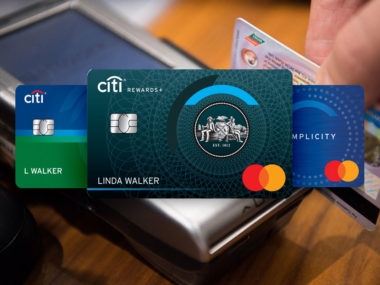“You can save 20% if you open an account today!”
How many times have you heard this, or a similar pitch, when checking out at your favorite retailers? It seems like nearly every store has its own credit card offer these days, all trying to entice you with bigger discounts and extra perks. All you need to do is supply some basic information, and within minutes you’ll have a new card that you can use immediately.
Store credit cards are often enticing, especially when you regularly shop a specific brand. Although the potential discounts can save you money, carrying a wallet full of store credit cards isn’t always a smart financial strategy. Applying for too many lines of credit can hurt your credit score, and unless you use the cards wisely, they could cost you more in the long term.
Knowing exactly what you’re getting into before you apply as well as the best strategies for using store cards will help you get the most from them and avoid taking on too much debt.
Table of Contents
What Is a Store Credit Card?
A store credit card is a credit that can only be used at a specific retailer. Unlike a gift card, which gives you a specific amount of money to spend like cash, a store card is a credit account with a spending limit and a balance that you need to pay off.
Retailers often entice customers to open a store card with the promise of perks, including bigger discounts than those available to the general public, rewards for purchases, free shipping on online orders, and more. For people who shop at that store often, these perks can add up to big savings, while also freeing up cash (at least in the short term) for other purchases.
How Are Store Cards Different From Regular Credit Cards?
When you open a “regular” credit card, such as a Visa or Mastercard, it can be used anywhere that card is accepted. The major difference with a store credit card is that a store card can only be used at a specific retail brand’s store, or within their family of brands.
Another big difference between regular and store cards is the interest rate. Although some store cards offer low introductory rates, or low to no interest on purchases paid within a certain timeframe, generally speaking, store card interest rates are much higher than those of regular cards. CBS News reports that the average store card interest rate is 26.01%, higher than the average credit card interest rate of 21.1%. Some store cards have even higher rates, topping out at 29.99%.
In exchange for those higher interest rates, store credit card holders typically enjoy some perks. Some of the most common perks include discounts (a hefty first purchase discount, a smaller discount on every purchase, extra discounts on specific days), rewards tied to spending levels, birthday or anniversary gifts (usually a discount or “free” reward of some type), free shipping, free personalization services, and deferred interest promotions.
Again, unlike the perks that come with regular credit cards, these benefits are tied to the specific retailer. With a rewards card, for instance, you might earn points or cashback that can be used anywhere, but your store card rewards are only redeemable at that retailer.
Another drawback to store cards is that they often start with lower limits than regular credit cards. A new store card might have a starting credit limit of $300 to $500, making it easy to max out that card with only a few purchases.
What Are Co-Branded Store Credit Cards?
Another type of store credit card is the co-branded card. This is a regular credit card branded with a specific retailer; for example, Walmart and Target both offer co-branded credit cards in addition to store-specific credit cards. Click here for more information on how to get a Walmart credit card. The major difference between a co-branded card and a store credit card is that a co-branded card can be used anywhere, not just at that particular retailer.
Some co-branded cards are also rewards cards. If the retailer offers a rewards program, their rewards credit card earns points towards rewards for all purchases, with purchases made at the co-branded retailer earning more points. The catch? The rewards can only be used at that specific store.
In other cases, co-branded cards are designed to give customers access to the perks of carrying a store card, with the flexibility to use it anywhere. The Target Red Card, for instance, gives cardholders a 5% discount on all purchases, free shipping on online purchases, an extended return period, and access to exclusive offers. The Target Mastercard offers the same benefits, but can be used everywhere — not just at Target.
Co-branded store credit cards offer greater flexibility, but they typically require a higher credit score than store cards. In most cases, the interest rate on these cards is the same as the store card.
Examples of Store Credit Cards
In addition to big-box retailers like Target and Walmart, a wide range of other stores offer credit cards. These include:
- Department stores, including Macy’s, JCPenney, and Nordstrom;
- Specialty retailers, such as Best Buy, Apple, Dell, Dick’s Sporting Goods, and Cabela’s;
- Clothing chains, such as Victoria’s Secret, American Eagle, and Old Navy;
- Online retailers, such as Amazon and Overstock;
- Home goods, including Lowe’s, The Home Depot, Pottery Barn, and Wayfair;
How to Get a Store Credit Card
Generally speaking, getting a store credit card is easy. You can usually apply in person at the store, or online. You’ll need to supply some basic information, including your Social Security number and income information, and you will typically get an answer on the spot.
Most store cards require at least a fair credit score between 580 and 669. Co-branded cards typically have more stringent requirements. Your individual credit history will determine the initial limit for the card.
Examining Store Credit Card Rewards
Store card rewards vary considerably, but almost always include some type of discount and rewards/loyalty program. More specifically, you might expect:
- An initial purchase discount, usually 20 to 30 percent off your first purchase
- A discount (usually 5%) off all purchases;
- Special shopping days with higher discounts;
- Early access to sales and promotions;
- Rewards for purchases based on spending (you might earn two points for every $1 spent, for instance);
- Free shipping;
- Birthday coupons or rewards;
- Free personalization;
- Extended returns periods;
- Access to discounts and offers from partner brands;
- Deferred interest offers;
Generally speaking, if you are loyal to a particular brand and shop often — and pay your balance in full every month — the benefits of a store card will save you money. However, because of their high-interest rates, carrying a balance on these cards will effectively negate any savings you might enjoy. And considering that earning rewards often requires spending hundreds of dollars, that $5 or $10 coupon you get might not be as beneficial as it appears.
Best Practices for Using Store Credit Cards
Using retail credit cards wisely can be a way to save money in stores where you shop regularly. And since these cards are relatively easy to get, they can help you establish a credit history or rebuild it if you have had trouble in the past.
That said, there are some drawbacks to using these cards. The high-interest rates are one of the biggest drawbacks, since they can easily add hundreds or even thousands of dollars to your balance if you don’t pay it in full every month. Carrying store cards can also decrease your willingness to shop around. When you can easily make a purchase with that card and enjoy perks, you’re less likely to comparison shop for the best deals, which might save you more money than purchasing from a specific retailer.
Worst of all, though, misusing store cards can torpedo your credit and make it harder to qualify for low rates for car loans, mortgages, and other credit cards. When you carry a high balance, miss payments, or are late on your payments, your credit score takes a hit.
In fact, it’s easy for store cards to snowball out of control after just a single purchase. If you miss a payment, the late fees and interest start to rack up, and even if you pay the balance in full, you’ll have negative information on your credit report that can come back to haunt you. For that reason, it’s vital to manage your store cards responsibly. This includes:
- Paying the balance in full every month, or through deferred interest payments. Ideally, you should only use store cards to get the discounts and perks when you have the cash to cover the purchase, so you can pay the bill right away.
- Setting up automated payments so you are never late or miss a payment.
- Not opening many store accounts. Although store cards can increase your available credit, too many can lower your credit score.
- Avoiding store cards with annual fees, which can negate any savings the store card offers.
Image Source: https://depositphotos.com/





